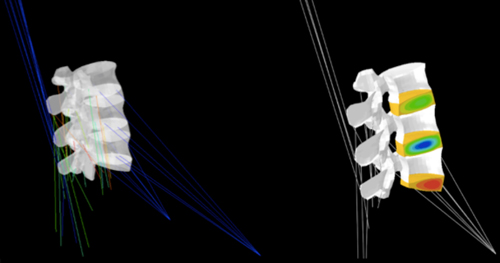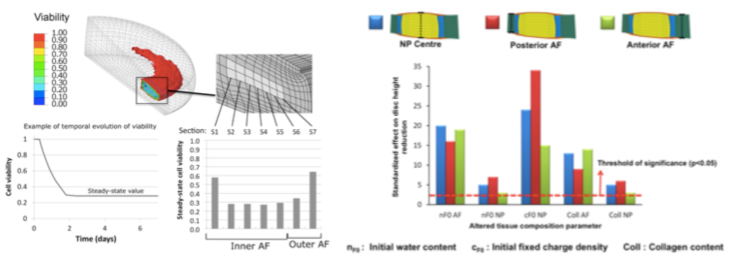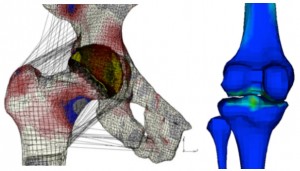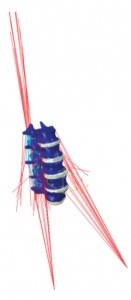 Former Members Dr. Jérôme Noailly | Principal Investigator Now: SIMBIOSYS (Simulation, Imaging and Modelling for Biomedical Systems), UPF
Former Members Dr. Jérôme Noailly | Principal Investigator Now: SIMBIOSYS (Simulation, Imaging and Modelling for Biomedical Systems), UPF
Description

Biomechanics (spine, lower limbs); Mutiphysics (cartilage, intervertebral disc, artery); Biophysics (intervertebral disc nutrition, cytokines); Computational analyses (finite element element, numerical optimisations, stochastic modelling); In vitro experiments (dynamic culture, tissue/biomaterial mechanical characterisation)

Research in the group of Biomechanics and Mechanobiology focuses mainly on (i) the interactions between tissue multiphysics and biological processes, and (ii) how these interactions can affect the functional biomechanics of organs. Numerical methods based mostly but not exclusively on FE modelling are used to describe both the tissues at the organ level, and the tissue-cell interactions at the tissue and cellular levels. The numerical concepts developed are tested against in vivo and in vitro data, which allows model validations. Emphasis is given in the study of load transfer of organ conditions onto the cells or onto tissues, with or without treatment simulations. Calculations are based on mechano-regulation and/or on biophysical concepts to predict different cell environments over time.

Most tissue and biophysical models developed so far aimed to study one of the most complex organs of the musculoskeletal system, namely the spine. Thorough knowledge about the functional biomechanics of the lumbar spine has been acquired along the time in relation to computational simulations (J Biomech, 40, 2414-25; Biomech Model Mechanobiol, 10, 203-19). In order to capture as best as possible the communications between organ and tissue biomechanics, studies of advanced tissue models have been performed, in relation to the vertebrae (Mater Lett, 78, 154-58), to the intervertebral discs (J Mech Behav Biomed Mater, 4, 124-41; Comput Meth Biomech Biomed Engin, 16, 923-8) and to the muscles (J Biomech, 45, S484).

In particular, these models allowed thorough identification of the tissue parameters expected to alter cell nutrition in a deforming intervertebral disc (PLoS Comput Biol, 7, e1002112), leading to further relations between tissue condition and cell viability (Poromechanics V, 2193-2201). Care is also taken to assess the physical meaning of the tissue model parameters, and the mechanistic aspect of the simulation work is supported by both stochastic modelling and bioreactor experiments.

The numerical stability of these models is also one target of the explorations performed within the group (J Mech Behav Biomed Mater, 26, 1-10), in order to ensure the coupling to lower scale biophysical models. Also, models have been used to for implant simulations focussed either on clinical (J Appl Biomat Biomech, 4, 135-42), or on design questions (Eur Spine J, 21, S675-87). Beyond the spine domain, both knowledge and know-how acquired are being transferred to the exploration of the cardiovascular system. Also, on-going clinical collaborations are contributing to the adaptation of the numerical methods to study problems and treatment solutions related to the lower limbs (J Biomech, 45, S163).
News/Jobs
Really Useful Group: VPH-DARE, mySpine, ARTreat
15/09/14
The newsletter of the VPH-Share EU project contains an article in which Jérôme is interviewed about the MySpine project.
«Vertebral Endplate Morphology and Permeability»
01/08/14
Some of the group’s latest published work has been featured by the software company SIMPLEWARE.
Marie Curie IOF for IBEC researcher
11/06/14
Andrea Malandrino, a postdoc in IBEC’s Biomechanics and Mechanobiology group, will spend two years at the Massachusetts Institute of Technology (MIT) with a Marie Curie International Outgoing Fellowship.
Research on muscle modelling at IBEC’s BMMB group rewarded twice!
29/11/2013
Themis Toumanidou, PhD candidate in the BMMB group, has been recently rewarded with the best scientific contribution to the Third Annual Meeting of the Spanish Chapter of the ESB. Themis is working on the development of a muscle constitutive model that is able to act as a strain-activated motor, helping the deformation imposed to the fascicles, as it is necessary to generate voluntary motions. The model has been coupled to a finite element model of the lumbar spine, and has shown its ability to interact with the fluid pressurization simulated in the intervertebral disc, leading to the calculation of intradiscal pressure values close to those measured in vivo. She had already won the prize for the best flash presentation at the 2013 IBEC Symposium.
IBEC organizes the III Meeting of the Spanish Chapter ESB
25/10/2013
Yesterday the III Spanish Chapter Meeting of the European Society of Biomechanics (ESB) was celebrated and organized by the Institute for Bioengineering of Catalonia (IBEC). The event took place at the Parc Científic de Barcelona (PCB) and hosted 60 people from research centres, hospitals and universities throughout Spain.
UPC’s new BIOMEC group to boost collaborative research
09/09/2013
In July the UPC’s governing council approved the creation of two new research groups, one of which involves IBEC’s Biomechanics and Mechanobiology researcher Jérôme Noailly as one of the founding researchers. The new Biomechanics Engineering (BIOMEC) group at the UPC, led by Josep Maria Font and supported by IBEC researchers, is concerned with the integration of the biomechanics of human movement to tissue scale biomechanics. In such a context, the aim is to create a network of researchers who focus their research in biomechanics from different perspectives. For example, while the biomechanics of human movement is a strong field of expertise of the team of Josep Maria Font at UPC, tissue mechanics and multiphysics is that of Jérôme Noailly’s team at IBEC. Indeed, the co-direction of student projects that spread among these two disciplines has already started through an integrated study of the biomechanical rationales subjacent to the problem of juvenile coxarthrosis. Such a project links two important disciplines resectively related to “external” and “internal” biomechanics, and establishes a first template to link together particular body functions and tissue conditions including biophysical regulation aspects. “Through the creation of the BIOMEC group we are also starting a common program of research seminars, and the next step is to ask for common grants,” explains Jérôme Noailly, Senior Research Associate in IBEC’s BMMB group. “We plan to have common PhD students that can have both affiliations too.”
«Technology transfer in computational biomechanics: from concept to clinics»
24/07/2013
The group has produced a poster to explain their technology transfer activities.
BMMB group to host next ESB Spanish Chapter meeting
24/07/2013
The BMMB group will be co-organising and hosting the third meeting of the Spanish National Chapter of the European Society of Biomechanics (ESB) at IBEC on 23rd-24th October 2013. The meeting itself will take place on the 24th, while the 23th will be dedicated to the organization of three additional courses related to biomechanical modeling for patients. The Spanish National Chapter was created in 2011, and the first and second Chapter meetings were held in Zaragoza and Seville. In addition to the scientific quality of the papers presented, these two events marked important guidelines: the first meeting elected the first Executive Committee, of which Jérôme Noailly is a member, and the second set up awards to recognize the scientific quality of the work of the chapter members. In line with previous meetings, the goals of the 2013 meeting are: • To present the work of different Spanish groups in the field of biomechanics; • To promote the National Chapter and the ESB to other Spanish groups working in biomechanics; • To support the creation of partnerships between different groups in Spain; • To serve as mediator for doctors and clinical professionals who are interested in biomechanics; • To present the progress and new initiatives from the Executive Committee and collect the opinions of the Chapter members to establish a roadmap for the coming year. The deadline for submission of abstracts is September 19th. More information is available at http://capituloesb.ibecbarcelona.eu.
The Biomechanics and Mechanobiology group is offering 4 positions for the completion of master projects at IBEC
18/10/2012
Now closed
Positive review for MySpine
21/09/2012
The IBEC-coordinated European project MySpine, which reached its midpoint at the end of August, received a positive appraisal at its first Annual Review in Brussels in June.
«A patient-specific predictive platform to treat back pathologies»
14/12/2011
The European Research Media Center’s website, youris.com, features an article about the MySpine project, which is coordinated by IBEC group leader Damien Lacroix.
Researchers shed new light on predicting spinal disc degeneration
05/08/2011
The misery of lower back pain is, unfortunately, all too familiar to many people. Now researchers have taken a big step towards understanding one of the most common and debilitating complaints in the industrialized world, with results that could help to predict the onset of disc degeneration.
«L’estudi de l’efecte biomecànic sobre el cos humà»
15/07/2011
The Biomechanics and Mechanobiology group’s work and Damien Lacroix’s recent ERC grant is the subject of an article in this month’s Teraflop, the magazine of the Centre de Serveis Científics i Acadèmics de Catalunya (CESCA).
ERC Starting Grant for IBEC researcher
25/05/2011
Biomechanics and mechanobiology group leader Damien Lacroix has been awarded a prestigious European Research Council (ERC) Starting Grant for his research on finite element simulations of mechanobiology in tissue engineering.
Kick-off meeting of MY SPINE
23/03/2011
The kick-off meeting of one of IBEC’s EU projects, MySpine, is taking place at the institute this week. The consortium partners from the Netherlands, Austria, France, Spain and Hungary have gathered to outline the work packages for ‘Functional prognosis simulation of patient-specific spinal treatment’ and discuss the plans for the next six months.
Ràdio 4: Interview with Damien Lacroix about MySpine
16/01/2011
An interview with Biomechanics and mechanobiology group leader Damien Lacroix about the new EU-project he coordinates, MySpine, has been broadcast on Ràdio 4’s L’Observatori programme.
MySpine: a virtual spine for a real problem
21/12/2010
EU-funded project aims to improve treatment and prognosis of spinal diseases
Dr. Damien Lacroix elected president of the European Society of Biomechanics (ESB)
20/07/2010
Dr. Damien Lacroix, head of the research line Biomechanics and Mechanobiology of IBEC, has been elected president of the European Society of Biomechanics (ESB). Damien Lacroix has belonged to the ESB since 1999, and been part of the council since 2004. He is author of 27 articles in specialized journals and has participated in more than 80 conferences.
Prize for excellence in research on biomaterials
29/04/2010
Damien Lacroix, group leader in research on Biomechanics and Mecanobiology at IBEC (Institute for Bioengineering of Catalonia) has been awarded a prize by the European Society for Biomaterials (ESB) for his innovative contributions in the field of biomaterials.
Projects
EU-funded projects
| My Spine: Functional prognosis simulation of patient-specfic spinal treatment for clinical use | EU – Cooperation – FP7-ICT | Jérôme Noailly |
Publications
Equipment
- High performance computing infrastructure (48 cores, 256 GB RAM and over 11TB disc space, machine virtualization)
- Image reconstruction, Agent-based modelling, and Finite Element software technologies
- Bose ElectroForce BioDynamic bioreactor system (orthopaedic, cardiovascular, and customized configurations)
- Microfluidic chamber
Collaborations
- Dr. Josep Maria Font Universitat Politècnica de Catalunya BarcelonaTech, Barcelona, Spain
- Prof. Antoni Susín Universitat Politècnica de Catalunya BarcelonaTech, Barcelona, Spain
- Dr Ludovic Humbert Universitat Pompeu Fabra, Galgo Medical SL, Barcelona, Spain
- Dr. Joan Carles Monllau, Dr Ion Carrera Hospital de la Santa Creu i Sant Pau, Barcelona, Spain
- Dr. Màrius Valera Hospital de la Santa Creu i Sant Pau, Barcelona, Spain
- Dr Gianluca Vadalà Campus Bio-Medico University of Rome, Italy
- Prof. Mauro Alini AO Research Institute – AO Fundation, Davos, Switzerland Dr Benjamin Gantenbein, Dr Samantha Chan University of Bern, Switzerland
- Prof. Stephen Fergusson ETH Zurich, Switzerland
- Dr. Aron Lazary, Dr Péter Pál Varga National Center for Spinal Disorders, Budapest, Hungary
- Prof. Christian Hellmich Vienna University of Technology – Institute for Mechanics of Materials and Structures, Vienna, Austria
- Prof. Marie-Christine Ho Ba Tho Compiègne University of Technology, Compiègne, France
- Prof. Hans-Joachim Wilke Institute of Orthopaedic Research and Biomechanics, University of Ulm, Germany
- Prof. Keita Ito Eindhoven University of Technology, Eindhoven, The Netherlands
- Prof. Damien Lacroix University of Sheffield, UK
- Dr José Pozo, Prof. Alejandro Frangi University of Sheffield, UK
- Dr Juan Fernando Ramírez Patiño, Universidad Nacional de Colombia, Medellín, Colombia

